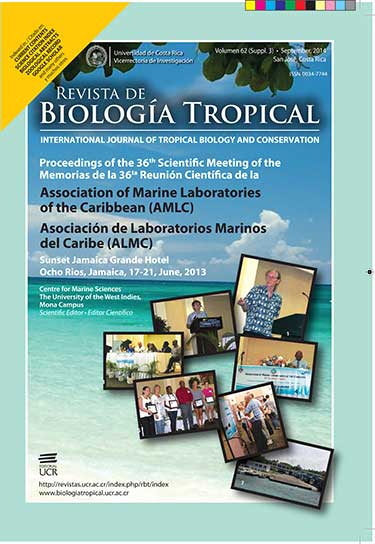Abstract
Three decades ago, Acropora palmata was one of the main reef-building coral species throughout the Caribbean, forming an essential component of the structural complexity of shallow coral reef habitats. These colonies still provide microhabitats for settlement, food and shelter to many vertebrates and invertebrates. The recent decline of A. palmata has been followed by a significant loss in spatial heterogeneity and possibly in species diversity. Studies addressing whether dead and living stands of Acropora hold different fish and benthic assemblages are scarce. The status of Acropora colonies and their associated species were assessed in October 2012, at two reef zones of Cayo Sombrero, Venezuela. Visual censuses of fish abundance and the number of macrofaunal individuals were recorded for both live and dead zones. Living Acropora colonies had the lowest abundance (˂31%). In both zoned the fish community was dominated by damselfishes (˂53%) and wrasses (˂36%), the benthic macrofauna by peracarid crustaceans (˂40%) and polychaetes (˂38%). Fish and benthic communities were not correlated with the condition (live or dead) of the Acropora habitats; possibly branching structures provide the necessary shelter and protection no matter if they are dead or alive. More replication is necessary to test this unexpected result. Rev. Biol. Trop. 62 (Suppl. 3): 85-93. Epub 2014 September 01.
References
Anderson, M. J. (2001). A new method for non-parametric multivariate analysis of variance. Australian Ecology, 26, 32-46.
Aronson, R. B., & Precht, W. F. (2001). White-band disease and the changing face of Caribbean coral reefs. Hydrobiologia, 460, 25-38.
Baums, I., Bythell, J., Lirman, D., Gladfelter, E., Miller, M., Mueller, E., Ortiz, A., Rueda, P., Vargas, B., Vermeij, M., Vollmer, S., & Weil, E. (2002). Report from the Biology and Ecology Working Group. In Bruckner, A. W. (ed). Proceedings of the Caribbean Acropora workshop: potential application of US endangered species act as a conservation strategy NOAA. Technical Memorandum NMFS-OPR-24, Silver Spring, MD.
Bone, D., & López-Ordaz, A. (2009). Programa de monitoreo ecológico, ecotoxicológico y ambiental de arrecifes coralinos en el Parque Nacional Los Roques comunidades bentónicas asociadas a los sedimentos. Caracas, Venezuela: Unpublished Report.
Bonin, M. C. (2012). Specializing on vulnerable habitat: Acropora selectivity among damselfish recruits and the risk of bleaching-induced habitat loss. Coral Reefs, 31, 287–297.
Bortone, S., Hastings, R. & Oglesby, J. (1986). Quantification of reef fish assemblages: a comparison of several in situ methods. Northeast Gulf Science, 8, 1-22.
Chasqui-Velasco, L., Alvarado, E., Acero, P., & Zapata, F. (2007). Efecto de la herbivoría y coralivoría por peces en la supervivencia de corales trasplantados en el Caribe colombiano. Revista de Biologiá Tropical, 55, 825-837.
Cróquer, A., & Bone, D. (2003). Las enfermedades en corales escleractínidos: ¿Un nuevo problema en el arrecifede Cayo Sombrero, Parque Nacional Morrocoy, Venezuela? Revista de Biologiá Tropical, 4, 167-172.
Escobar-Briones, E., & Jiménez-Guadarrama, L. (2010). Macrocrustáceos (Peracarida, Decapoda) de fondos carbonatados del sector occidental del banco de Campeche en el sur del golfo de México. Revista Mexicana de Biodiversidad, 81, 63-72.
García, A., Cróquer, A., & Pauls, S. (2003). Estado actual de las enfermedades y otros signos de deterioro coralino en siete arrecifes del Parque Nacional Archipiélago de Los Roques, Venezuela. Revista de Biologiá Tropical, 51, 173-180.
Gómez, J. C., Ricaurte, C., Mayo, G., Orejarena, J., Díaz, J. M., & Andrade, C. A. (2010). Cobertura de los fondos y paisajes bentónicos asociados a formaciones diapíricas en los Bancos de Salmedina, Plataforma Continental del Caribe Colombiano. Bologiá Invemar, 39, 117-135.
Glynn, P. (1991). Coral reef bleaching in the 1980s and possible connections with global warming. Trends in Ecology and Evolution, 6, 175-179.
Lemoine, N. P., & Valentine, J. F. (2012). Structurally complex habitats provided by Acropora palmata influence ecosystem processes on a reef in the Florida Keys National Marine Sanctuary. Coral Reefs, 31, 779-786
Lirman, D. (1999). Reef fish communities associated with Acropora palmata: relationships to benthic attributes. Bulletin of Marine Science, 65, 235-252.
López-Ordaz, A., & Rodríguez-Quintal, J.G. (2010). Ictiofauna asociada a un arrecife somero en el Parque Nacional Morrocoy, Venezuela. Revista de Biologiá Tropical, 58, 163-174.
Martínez, K., & Rodríguez-Quintal, J.G. (2012). Caracterización de las colonias de Acropora palmata (Scleractinia: Acroporidae) en Cayo Sombrero, Parque Nacional Morrocoy, Venezuela. Bological Institute of Oceanography, Venezuela, 51, 67-74.
Randall, J. E. (1967). Food habits of reef fishes of the West Indies. Studies in Tropical Oceanography, 5, 665-847.
Rodríguez, J., & Villamizar, E. 2008. Estructura de la comunidad íctica en dos arrecifes con diferentes grados de afectación en el Parque Nacional Morrocoy, Venezuela. Acta Biologia Venezuela, 28, 61-69.
Rogers, C. S. (1990). Responses of coral reefs and reef organisms to sedimentation. Marine Ecology Progres Series, 62, 185-202.
Winfi, I., & Escobar–Briones, E. (2007). Anfípodos (Crustacea: Gammaridea) del sector norte del Mar Caribe: listado faunístico, registros nuevos y distribución espacial. Revista Mexicana de Biodiversidad, 78, 51- 61.
Yánez-Rivera, B. (2009). Amphinomidae Savigny in Lamarck, 1818. p.p. 77-87. In De León-González, J. A., Bastidas-Zavala, J. R., Carrera-Parra, L. F., García-Garza, M. E., Peña-Rivera, A., Salazar- Vallejo, S. I., & Solís-Weiss, V. (Eds). Poliquetos (Annelida: Polychaeta) de México y América Tropical., México: Universidad Autónoma de Nuevo León, Monterrey.
Zubillaga, A. L., Márques, L. M., Cróquer, A., & Bastidas, C. (2008). Ecological and genetic data indicate recovery of the endangered coral Acropora palmata in Los Roques, Southern Caribbean. Coral Reefs, 27, 63-72.
##plugins.facebook.comentarios##

This work is licensed under a Creative Commons Attribution 4.0 International License.
Copyright (c) 2014 Revista de Biología Tropical


